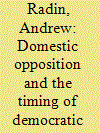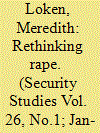|
|
|
Sort Order |
|
|
|
Items / Page
|
|
|
|
|
|
|
| Srl | Item |
| 1 |
ID:
153936


|
|
|
|
|
| Summary/Abstract |
Private military and security companies are integral components of the defense and intelligence operations of some of the world's most powerful states. Despite the increasingly pivotal role of contractors, analysts have yet to develop theories explaining when governments should outsource national security responsibilities or what conditions cause private defense markets to function efficiently. This inquiry addresses this gap in the literature by demonstrating that varying market structures—that is, the quantity of firms providing similar services and the number and purchasing power of those buying these services—have significant effects on costs, oversight, and company performance in the private defense industry. A principal–agent framework is developed to explain variation in the performance of firms in different markets across the industry. Evaluation of three private defense markets yields the surprising conclusion that monopsony, rather than a competitive market, is the ideal structure for governments outsourcing aspects of national defense.
|
|
|
|
|
|
|
|
|
|
|
|
|
|
|
|
| 2 |
ID:
153939


|
|
|
|
|
| Summary/Abstract |
Can states credibly communicate their intentions through covert policy tools, despite the absence of credibility-enhancing publicity? Most extant research suggests covert action and secrecy in general are uniquely uninformative and often used as an alternative to signaling. Yet episodes such as Richard Nixon's secret bombing of Cambodia suggest that leaders have used covert action to convey intentions and coerce adversaries. This article builds a theoretical framework for understanding signaling in the covert sphere, developing reasons why states find covert communication both intelligible (that is, the basic intended message is understandable) and credible (that is, the message is believable). We argue that two target audiences—local allies and strategic adversaries—tend to observe covert action and that the costs and risks incurred by initiating and expanding covert action credibly convey resolve. We assess our arguments empirically through careful process tracing of a set of nested covert interventions by Soviet and American leaders in conflicts in Angola and Afghanistan. Drawing on a trove of recently declassified material, we assess intentions and inferences related to covert signaling. We find that both strategic adversaries and local partners observed and drew inferences about resolve. Covert lethal aid programs thereby served as a credible indicator of resolve through three mechanisms we identify in the paper: sunk costs, counter-escalation risks, and domestic political risks. These findings have important implications for the study of coercive bargaining, secrecy, and reputation. They also shed light on an important policy tool contemporary policymakers will likely use, suggesting the kinds of effects covert action has and elucidating the basic interpretive framework needed to communicate messages with new methods like covert cyber attacks.
|
|
|
|
|
|
|
|
|
|
|
|
|
|
|
|
| 3 |
ID:
153938


|
|
|
|
|
| Summary/Abstract |
A substantial literature urges delaying elections and liberalization in postwar societies. There is little work, however, on when and how international missions that intend to delay elections and the transfer of sovereignty, such as those in Kosovo and Iraq, are able to do so. To fill this gap, I propose a theory that identifies conditions under which two forms of domestic opposition—elite objections and mass demonstrations—can at times force the international community to adopt an earlier transition plan. Following the predictions of the theory, I show that international occupations in Kosovo and Iraq were only able to implement their preferred transition plans when conditions were unfavorable for domestic opposition: when the absence of centralized authority within key groups makes an elite boycott unlikely, and when international policy does not threaten a major group's nationalist goals, making the emergence of widespread mass demonstrations doubtful. The implication for policy is that attempting to delay elections and liberalization is only advisable when domestic opposition is unlikely to be effective.
|
|
|
|
|
|
|
|
|
|
|
|
|
|
|
|
| 4 |
ID:
153944


|
|
|
|
|
| Summary/Abstract |
This study contributes to the debate on the role of nonnuclear (conventional) deterrence in international security by examining the Israeli practice of this strategy. By analyzing a case outside of Western strategic thought, which traditionally has dominated deterrence theory, it demonstrates how strategic thinking evolves differently in various ideational realms. The article highlights the impact of strategic culture on the Israeli conceptualization of deterrence, explores its deficits, and yields lessons for theoreticians and practitioners from the challenges of intra-war coercion operations. The study introduces the innovative term “culminating point of deterrence,” calls for improving analytical techniques for deterrence evaluation, claims that successful conventional deterrence perpetuates political conflict, stimulates the adversary's dangerous innovations, and argues for a tailored approach not only for formulating deterrence strategy, but also for exploring deterrence policies of different actors. The findings of the study are applicable beyond the Israeli case and are relevant to actors utilizing coercion strategies.
|
|
|
|
|
|
|
|
|
|
|
|
|
|
|
|
| 5 |
ID:
153935


|
|
|
|
|
| Summary/Abstract |
This article presents a theory of provocations. Precisely, it defines provocations as actions or incidents that state actors perceive as intentionally and wrongfully challenging or violating their values and goals, thereby eliciting outraged reactions that spur rash, aggressive responses. Outraged reactions come in three forms: personal, performative, and popular. While each form is different in nature, all work to produce strong—albeit temporary—pressures for rapid, retaliatory satisfaction. Importantly, these reactions can be mutually reinforcing and are not immune to further amplification by the actions of those with ulterior motives, political or otherwise. By laying out these dynamics, it becomes possible to understand how provocative actions can lead state actors to engage in behavior—such as France's headlong rush into defeat in the Franco–Prussian War—that would otherwise be quite puzzling.
|
|
|
|
|
|
|
|
|
|
|
|
|
|
|
|
| 6 |
ID:
153937


|
|
|
|
|
| Summary/Abstract |
There is widespread variation in scope, scale, and forms of rape across and within conflicts. One explanation focuses on the integration of women in armed groups. Scholars and international organizations posit that the inclusion of women in armed groups discourages wartime rape. They advocate women's increased participation to combat rape and other forms of civilian violence. Using an original dataset of women's involvement as combatants in civil wars from 1980 to 2009, I argue that the participation of female fighters has no significant impact in constraining an armed group's propensity to rape. Female combatants do not lessen rape because organizational factors, primarily culture, drive violence in armed factions and encourage conformity irrespective of individual characteristics. Advocating further militarization of women in an attempt to reduce conflict-related rape may be an ineffective policy prescription.
|
|
|
|
|
|
|
|
|
|
|
|
|
|
|
|
|
|
|
|
|